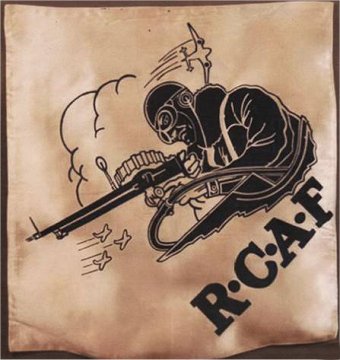 During WW II, popular souvenirs were cushion covers showing
Squadron Crests, etc. The above cushion cover appeared for sale on
E-Bay and sold for $150.00 US to a buyer in England. It depicts an Air
Gunner in an open cockpit, firing a .303 gas operated Vickers machine gun
mounted on a scarthring. The Vickers K was fitted to a number of two and
three-seater aircraft in British service such as the Fairey Swordfish,
Fairey Battle and Handley Page Hampden, and the Blackburn Sharks. It was
also used in gun turrets, such as the dorsal turret in the Bristol Blenheim
and the nose turret in the Armstrong Whitworth Whitley. Some Halifax
and Sunderland aircraft used them as waist guns.
During WW II, popular souvenirs were cushion covers showing
Squadron Crests, etc. The above cushion cover appeared for sale on
E-Bay and sold for $150.00 US to a buyer in England. It depicts an Air
Gunner in an open cockpit, firing a .303 gas operated Vickers machine gun
mounted on a scarthring. The Vickers K was fitted to a number of two and
three-seater aircraft in British service such as the Fairey Swordfish,
Fairey Battle and Handley Page Hampden, and the Blackburn Sharks. It was
also used in gun turrets, such as the dorsal turret in the Bristol Blenheim
and the nose turret in the Armstrong Whitworth Whitley. Some Halifax
and Sunderland aircraft used them as waist guns.
The maximum rate of fire was 950 rounds per minute, however
it was usually set at750 rounds per minute. The ammunition pans held 60
to 100 rounds, so one had to fire in short bursts.
We thank Gordon Goddard of Regina for providing us with
the picture of the cushion cover.
Major Gordon F. Goddard, CD3 , Email ggoddard@accesscomm.ca
Director, Saskatchewan Military Museum, Regina, SK
Ph. (306) 924-0748.
Gordon reminds us if we are ever passing through Regina
International Airport, take a moment to check out the Military display
placed there by the Military Museum.
Ted Hackett
Ah yes, the old Vickers VGO, we had one in the nose of
the Halifax for the Bomb Aimer to use. I do believe that it was referred
to as "the panic gun". I think the only time Jim fired it the
bag for the empty shells came loose and he had little brass things all
over the nose. It was similar to the Lewis Gun that we had when I
joined the Militia in 1941, (the 2nd Battalion The Cameron Highlanders.
Gad Sir, I could strip that sucker and put it back together in no time!
John Moyles
When operating the Vickers from an open cockpit, one
had to contend with the slipstream. When firing towards the rear the prop
blast would enter the adjustment vent on the back of the helmet causing
the headgear to balloon and goggles to vibrate. When firing to either Port
or Starboard the slipstream would tear at the goggles impeding vision.
Changing ammo drums while the Pilot was throwing the aircraft around was
another problem.
A War time account of Sergeant
Scratch
Sgt. Scratch was born in Saskatchewan, July 7, 1919,
and enlisted in the RCAF in Edmonton, as R60973 AC2 Scratch D. P. on July
20, 1940. He earned his wings as a Sgt. Pilot and flew with that rank for
a long time. He flew Liberators from Gander Bay, Newfoundland, as a co-pilot
on anti-submarine patrol. Scratch was good at his job and was eventually
raised to commissioned rank.
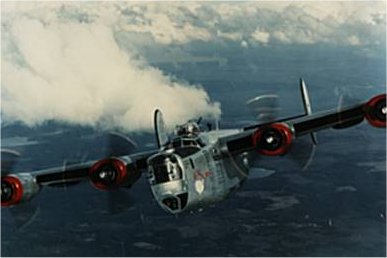
B-24 Liberator ~ Note mid-upper turret position
As a Flying Officer and with many hours to his credit,
Scratch wanted to fly as Captain, however, Airforce Officials considered
that, as he was slight in build, and had suffered ankle injuries in the
past, he would not have the strength to control a Liberator in an emergency.
Sgt. Scratch wanted more action but was unsuccessful in
getting an overseas posting. He became very depressed. One evening, June
19. 1944, in the mess, he entered into a debate about one man being able
to take off, fly, and land, a Liberator. Scratch left the mess, went down
to the hangar, fired up a Liberator, and took off. He shot up the American
base at Argentia, and the base at Gander. When some fighters approached
him to order him to land, they found him occupying, and rotating the mid-upper
gun turret, with the aircraft on autopilot. The guns were fully armed and
operational. When he returned to base he was placed under arrest, later
court marshalled, and dishonourably discharged.
Mr. Scratch returned to Edmonton, Alberta, and went directly
to the RCAF recruiting office where he was accepted back into the RCAF
as a Sergeant Pilot. He was posted to #5 OTU, Boundary Bay. #5 OTU was
training aircrew on Liberators for service against Japan. The Commonwealth
Air Training Plan was winding down and many of the Pilots were senior aircrew
from Training Command. Again Sgt. Scratch found himself flying second Pilot
to officers with far less experience than himself. The training started
on B-25 Mitchell aircraft and advanced to Liberators. When his experience
and flying skills were not recognized, Sgt. Scratch again became frustrated.
On December 5th. 1944, Sgt. Scratch attempted to take
off, unauthorized, in a Liberator, Due to the fact that there was no official
flying that night, the field was in darkness and the control tower un-manned,
Scratch mistook a roadway for the runway and crashed into a wooden bridge
wiping out the undercarriage. Undaunted, he returned to the hangar and
signed out a B-25 Mitchell and took off.
Scratch flew down to Seattle, Washington, area and beat
up the Seattle airport causing many aborted take offs. The Americans sent
up fighter aircraft to bring the Mitchell down however, Scratch returned
to Canada, disrupting and grounding flights at the Vancouver airport. He
then flew around the Hotel Vancouver, well below the roof level and down
Granvil St.
The following is an eye witness report by Norman Green.
“7:00 hrs. December 6, 1944, while it was still dark, I was in the mess
hall when it was shaken, and dishes fell to the floor as a result of an
aeroplane flying low overhead. The same pass shook WDs out of their bunks.
As usual that morning at 8:00 hrs., 1200 airmen and airwomen,
all ranks (I among them), formed up on the tarmac in front of the control
tower for CO’s inspection. Just as the parade was about to be called to
attention a B-25 Mitchell bomber came across the field at zero altitude,
and pulled up sharply in a steep climb over the heads of the assembled
airmen, just clearing the tower. Within seconds 1200 men and women were
flat on the ground. The Mitchell then made several 25 ft. passes over the
field. Group Captain Bradshaw dismissed the parade and ordered everyone
to quarters.
Over the next two hours we witnessed an almost unbelievable
demonstration of flying, much of it with the B-25’s wings vertical to the
ground, below roof top level, defying gravity. We were continually diving
into ditches to avoid being hit by a wingtip coming down a Station road.
He flew it straight and level, vertically with the wing tip only six feet
above the ground without losing altitude, defying all logic, and the law
of physics.”
After an hour of this, three P40 Kittyhawks from Pat Bay
Station arrived on the scene, fully armed, with orders to shoot the B25
down if it left the area of the station. They tried to get on his tail
but could not stay with him in his tight turns below rooftop level. After
two hours of this Sgt. Scratch flew over a corner of the field and circled
one spot vertically with the Kittyhawks joining in like May Pole dancers.
Sgt Scratch then climbed to 2000 feet and wagged his wings
as he crossed the field, boxed in by the fighters. When they were clear
of the station the Kittyhawks signalled Sgt. Scratch to land. He nodded
his head, gave them the thumbs down sign, rolled over, pulled back on his
controls, and, aiming at an uninhabited spot on Tillbury Island in the
Fraser River, dived into it. The shattered red taillight lens was later
located dead centre between the points of impact of the engines.
Could this tragedy have been prevented? Could Sgt Scratch’s
flying talents been better used in theatres where he wished to serve? Should
the Administration have recognized his expertise and frustrations, made
him Captain of his aircraft and crew, and posted him to a theatre of his
choice?
Whatever the motivation, there is one definite truth,
Sgt. Scratch, WAS A SUPERB PILOT
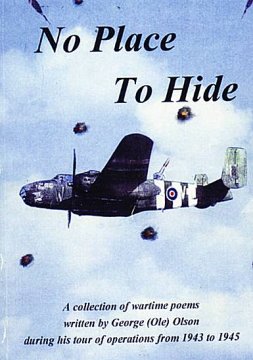 Ed.
I was not able to find a picture of a B-25 Mitchell with RCAF markings,
so we resorted to reproducing the cover of George Olson’s book of Operational
Poetry, NO PLACE TO HIDE.
Ed.
I was not able to find a picture of a B-25 Mitchell with RCAF markings,
so we resorted to reproducing the cover of George Olson’s book of Operational
Poetry, NO PLACE TO HIDE.
It is also an opportunity to promote George’s excellent
work.
For those not aware of this book, George, as WAG on
98 Squadron, would , on returning from an Operational flight, write a poem
recording the flight. Also in the book are extracts from his flying Log
Book and explanatory notes to enhance the poetry.
George is still writing poetry. I often turn to his
book for enjoyable reading. It is highly recommended.
ISBN 0-9687220-0-8
Publishers
LORAL FAMILY GROUP
P.O. Box 4810
Edmonton, A.B. T6E 5G6
George Olson
golson5@shaw.ca
Regina Veteran Honoured
In 1944, the 21 year old Hastings suffered a
crash while flying over Belgium. The event left him clinging to life with
32 facial fractures, three spinal fractures, and a broken leg.
Hastings was one of 18 Canadians who received a Minister
of Veterans Affairs Commendation. According to Veteran Affairs, the award
recognized Hastings’ experiences during the war and the sacrifices since
returning home. First handed out in 2001, the commendations recognize individuals
for outstanding service and post combat assistance to other veterans and
their families.
Lionel completed his first tour of duty in four months,
but volunteered to stay on and fly transport units out of Brussels. It
was during this tour that Lionel joined a flight ferrying wounded soldiers
back to England. The plane’s engines failed soon after take off. Lionel
rushed to place the helpless men into crash positions. As he headed back
to his seat, the Anson struck two power lines and crashed into a bomb crater.
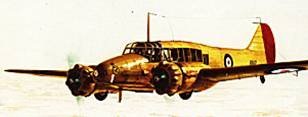
The Avro Anson, often referred to as “Faithful Annie”
He spent seven months recovering, including three in East
Grinstead’s Queen Victoria Hospital. Lionel became a member of the exclusive
“Guinea Pig Club”, reserved for airmen requiring extensive plastic surgery
“They even replaced my nose, which is good because there
is nothing in there.” He laughed, squishing his nose between two fingers.
“I think they did a good job.”
Lionel Hastings recently completed a book on his wartime
experiences: As for the Canadians: the Remarkable Story of the RCAF’s Guinea
Pigs of World War II.
For more on the Guinea Pig Club go to Short Bursts October
2003 Webzine:
http://www.hillmanweb.com/rcaf/mag/exag0310.html
If your Editor can acquire a copy of Lionel’s book, we
will review it in a future Short Bursts Webzine.
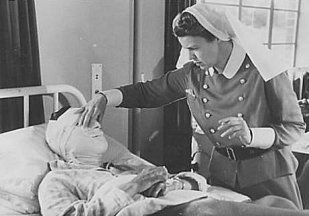
Angels of Mercy at the Queen Victoria
422 SQUADRON (R.C.A.F. WARTIME
1942-1945)
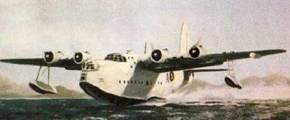
A CELEBRATION IN WINNIPEG!!!
#422 SOCIAL REUNION MAY 2007 - FOR THE 65th ANNIVERSARY
!!!
THE MAY 2007 422 SQUADRON REUNION IN WINNIPEG
BROUGHT TEN VETERANS AND TWENTY WIVES AND/OR FAMILY,
TO CELEBRATE 65 YEARS SINCE THE SQUADRON
WAS FORMED FOR THE BATTLE OF THE ATLANTIC
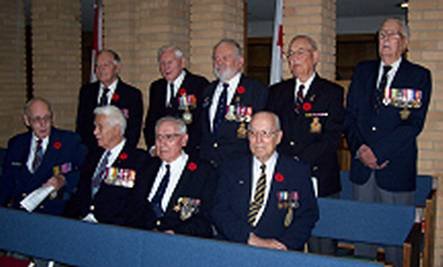
Back row – Jack Logan, Ken Pye, Stan Nichols,
Bob Paige, Charlie Rafter
Front row - Alex Logan, Doug Grinham,
Terry Reeves, Bud Crookes
Missing from photo – Harry Kerrison
Your Editor was unable to attend the reunion however our
crew, Captained by Doug Brooks, was represented by Pauline Brown and daughter,
Sharon, family of Ken Brown our Second Pilot. To give our readers their
impression of the reunion Sharon’s letter sums it up as follows.
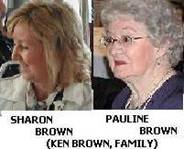 “…..
ever since the reunion I’ve wanted to tell you of how wonderful it was.
I know you would have loved it if you could have been there. What a wonderful
group of people. I never doubted it but I was struck by how rock solid
great it all was – because of the people. It was a great program. Harry
Kierson, Jean Doerne and Bud Crookes, carried the day. Harry gave a presentation,
with slides, about the Battle of the Atlantic, relaying messages from members
with such caring. Jean Doerne kept the process moving and spoke with such
great heart.
“…..
ever since the reunion I’ve wanted to tell you of how wonderful it was.
I know you would have loved it if you could have been there. What a wonderful
group of people. I never doubted it but I was struck by how rock solid
great it all was – because of the people. It was a great program. Harry
Kierson, Jean Doerne and Bud Crookes, carried the day. Harry gave a presentation,
with slides, about the Battle of the Atlantic, relaying messages from members
with such caring. Jean Doerne kept the process moving and spoke with such
great heart.
We especially liked Bud’s “memory mats” so we could all
recall what we wanted to share; since I test memory for a living, I thought
it was inspirational. These were laminated pages (placemats) with the web
page information of the Squadron Members and the reunion events schedule
on the reverse side. My experience was that everyone was just happy to
be there in spite of the bitter-sweet aspect of whether this was a final
reunion, the whole event was filled with good will. Bud spoke very movingly
Sunday at noon before we left, and he conveys the same sense on the website.”
Sharon, let us interrupt you to show the readers a sample
of the “Memory mats” which you mentioned. Bud Crookes was kind enough to
make up mats for Doreene and myself. Following is an example of the place
mats mentioned by Sharon.
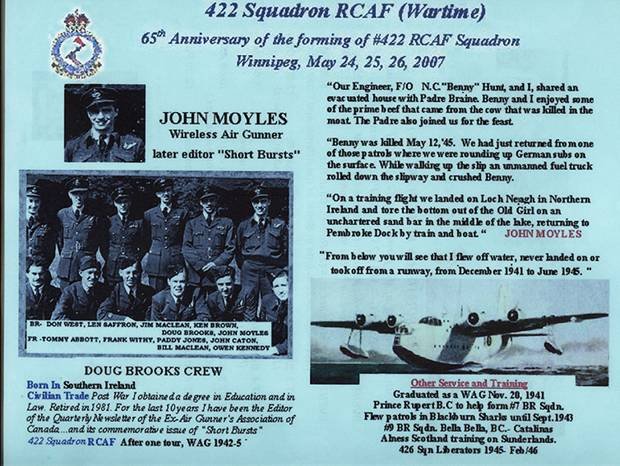
Sharon continues. “One of the touching events was when
a gallant fellow said to us, “Well, can I buy you ladies a drink.” Of course.
At one point I had the opportunity to just sit and, with Jack Logan and
others, watch a video of a Sunderland taking off. Looking at memorabilia
of Jean Doeren’s archival collection of prior reunions and pictures, helped
us appreciate the love and sense of camaraderie that has run so deeply.
I had a great time sitting with Bob Paige and his wife at the buffet. He
is the brother of a Squadron member who died and was specifically recognized
during the reunion
I was deeply inspired by connecting with such good people
for fellowship during the reunion. I think Dad would have loved it. I have
treasured Dad’s unwavering character and I recognize him in the ways you
remembered him to me.”
Bud Crookes, the Editor and founder of the 422 Squadron
Association Web Page, has the following message. “Web Page www.georgian.net/422squadron
is now a static web page with no further changes. Look it up to see the
final record of the Squadron activities, including our reunion (with pictures
of those present). Wartime music you can turn on while you peruse approx.
1500 separate pages. Anyone can now print off their own book, now that
it is out of print.
Cedric Mah
"Cheers"
Cedric Mah at the Edmonton Air Museum
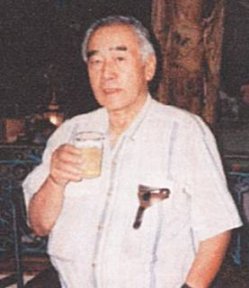
In June 2007 Short Bursts Page there is an article about
Cedric Mah, a young man from Prince Rupert B.C. who served his country
flying supplies over the Burma Hump into China. The following is
Cedric’s acknowledgement of the article and his news of a journey of a
lifetime.
Hi John, read your fine article today on our Forgotten
Theatre. By the way the printout I'm sending you is from the Hi John- Read
guy who discovered the headwaters of the Yangzi River. Hernie is the nickname
of Wong How Man. He's the explorer and photo journalist for National Geographic
in the Far East. The remnants of the CNAC Pilots and the Flying Tiger pilots
are invited to Shangri La.
Shangri la is a new village erected at the southeast corner
of the Himalayas. It will be a tourist haunt. Here in the shadow of the
Himalayas is a strip of grass forty miles long. It lies half way up the
Jade Dragon Mountains which rises to 20,000 feet. At Lijiang we used to
land before dawn into the mountain and takeoff downhill. We must get off
before the sun comes up for the heating caused the katabatic winds to flow
off the glaciers into the valleys. The winds can reach 80 to 100 miles
per hour. It was here that Kubilai Khan in 1253 stationed 250,000 head
of horse [men] to attack Burma and Annam (N. Vietnam).
From here we go along the Burma Road to Dali a quaint
village by an azure blue lake. It is famous for three pagoda's that
date back to 600 A.D. Marco Polo stopped here enroute to Ceylon (Sri Lanka).
During the war we wished we could get down to rest and swim.
From here the China Air Museum director, one of our wartime
co-pilots will have us driven west along the Burma Road to the China -
Burma Border. In 1943 one of our CNAC C-47's crashed on the 16,000
ft peaks.. Five years ago one of our 85 year old pilots crawled to the
crash site. No bones were found. Word got out that an 85-year-old pilot
climbed the mountains to bury his buddy hit the headlines. The Chinese
army sent 500 soldiers to slide it down. Now its at Pima Pass (10,000 ft.)where
we will dedicate the Interior Museum. The National Geographic, Imax Theatre
Group, and China Air Museum is footing the bill to visit Shangri-la.
By the way, the DND Veterans affairs has a video out on
Legion 280 in Vancouver. Both my brother Al and I are in the DVD Heroes
Remember.
Thanks again for the memo
Regards CED
MAH
Attention Members of 431 Squadron
Dear sir/madam,
Having recently been in contact with Linda Ibrom she
suggested I should contact you with the possibility of you helping me with
some research on my grandfather who served in 431 Squadron during 1943.
My grandfather F/O D.F. Rands was in 431 Sqdn from 25.1.43
until 26.11.43 when he and the rest of the crew aboard Halifax V,LK973,SE-E,
were lost on a mission over Frankfurt, Germany.
The full crew on that mission was:
P/O J.Morton (RAF)Pilot
F/O D.R.P.Short (RCAF)2nd Pilot
F/O D.F.Rands (RAF)Navigator
F/Sgt R.Holmes (RAF)Bomb aimer
P/O G.S.Milner Wireless op/Air gunner
P/O G.H.Rich (RCAF)Mid upper gunner
W/O M.G.Clynes,C.G.M (RAF)Air gunner
Sgt J.G.E.Laflamme (RCAF)Flight engineer
All the crew are buried at Durnbach war cemetery in Germany.
Most of this crew (J.Morton,D.F. Rands, R.Holmes, G.S.Milner)
& Sgt.T.Bell (Rear gunner) were on a mission to Stuttgart on 14.4.43
aboard Wellington X,HE201,(T) in which they issued a claim for 2 Me110's
destroyed and this encounter is retold in the book 'Royal Canadian Air
Force at war 1939-1945' by Larry Milberry & Hugh Halliday.
I have most of the details from the squadron ORB regarding
missions & various other written information from the RAF but what
I have been unable to obtain is archive material in the form of photographs,
either individual or crew, or of Halifax V,LK973.
My grandfather first flew with J. Morton on 27.10.42
in Wellington '208' of 16 OTU, the period at 16 OTU was 22.10.42 - 28.11.42.
While at 431 Sqdn he went to 1659 HCU between 6.8.43
- 12.8.43 to convert from the Wellington to the Halifax.
I would be grateful if you could list an appeal in your
'Short Bursts' magazine to help me in my quest for any relevant information.
Yours sincerely
Ian Rands.
ian@rands1990.fsnet.co.uk

Halifax 57 Rescue (Canada)
Registered Charity 84586 5740 RR0001
PROGRESS REPORT Number 20 ~
AUG. 1, 2007
www.57rescuecanada.com
To all our members and supporters of the Halifax Project
I am most pleased to be able to report on our continued success in our
ultimate goal to locate, inspect, and recover RCAF Halifax LW170 from the
deep.
The first thing on our agenda is to remind you of the
annual memorial function and celebrations at the Nanton Lancaster Society
Air Museum on August 25, 2007.
It will be bigger and better than ever with the spotlighted
group this year, the 8000+ Americans who flew in the RCAF. It will be a
full day of activities and ceremonies for the whole family and we urge
you to come out and see what our partners and friends are doing in Nanton,
“Canada’s Bomber Command Memorial”.
In our last Progress Report 19 I told you I would be meeting
on July 24 with the Irish officials of the deep sea research group to do
some “homework” on the sonar survey that we are planning later on this
year.
This meeting was held in Dublin as I was flying a flight
for Air Canada to Dublin and was able to arrange a meeting there with the
Irish sonar experts to discuss the Halifax sonar survey and the expedition
planning to locate the Halifax in our survey box.
When I first began investigating the area of ocean where
LW170 sank, which was 2 years ago, I was able to find that one sonar survey
had been done in that area over 5 years earlier by an Irish government
survey. I went to the Geological Surveys of Ireland (GSI) office in Dublin
and looked at their sonar survey data in our Halifax survey box area. Unfortunately,
because of the way the sonar data was processed, we could not see any targets
or anomalies on the bottom in our search box which were smaller that 300
meters across. (the Halifax is 35 meters X 25 meters)
With this disappointing fact in hand I continued on to
find any other information on the area within which our Halifax lies. I
was able to find out from other deep sea exploration groups, from all their
periodic surveys in the area, that there is only a weak current running
through the sonar box area, that the oxygen levels are low due to the depth
being at over 5000 feet, that the salinity in the area at that depth is
lower that at the surface, and that the temperature of the water where
LW170 is laying is a constant 3 degrees Celsius. It was also found out
that the ocean bottom texture in the area around LW170 is marine clay and
sand mix with a fairly solid base that should be able to support the weight
of the Halifax without too much sedimentation or concern that the Halifax
has sunk into the bottom elements. The bottom terrain in this area is like
small rolling hills or hummocks with only a very gradual sloping, almost
like prairie landscape.
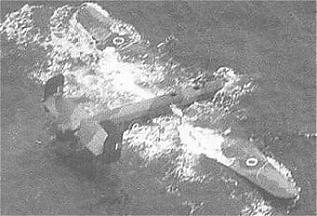
LW170 going down off Irish Coast
All of this data was acquired over these past 2 years
with the idea that, even if we did not have any past historic survey targets
to investigate when we went out on our sonar expedition, at least we would
know all about the area we were going to and what to expect for conditions.
On my first meeting with our Irish sonar experts on June
25, 2007 in Galway we all decided that we must leave no stone unturned
in looking for clues of the location of LW170. It was mentioned that there
was a new computer program for sifting through old sonar data and
that this program might be able to see anomalies on the bottom in our search
box that could be of the size of a Halifax bomber.
Our Irish experts said they would reprocess the data that
was available and that it would be ready for our next meeting which as
I told you was convened in Dublin last week, on July 24.
I was presented at that time with some great news from
our Irish experts as they had some very good results with the new processing
computer program. A big computer screen was used and all the anomalies
in the area of our sonar survey box, that had been sifted out from the
old sonar data, were presented to me. I was very excited to see several
definite targets in our box. I was also told that there were 2 very definite
solid targets in the area of our box which were only 1 to 2 miles away
from the sinking position of LW170 !
Further evidence of the qualities of these 2 prime targets
(which are about a mile apart) was shown to me that only an expert on sonar
could see. I was most heartened with this great news and thanked our Irish
friends for being so diligent and going the extra mile for us to help locate
LW170. It appears all of us are now fully into this historic quest for
LW170 and this sonar reconnaissance has yielded great dividends, through
the perseverance of our friends in Galway.
After evaluating the 2 prime targets we went on to discuss
the pending sonar survey to locate LW170. As we now have 2 prime targets
in our sonar box all our activities will be built around a survey that
emanates outward from these prime targets. IF, and the key word is IF,
we can get a good image of these targets and one of them shows us the final
resting place of RCAF Halifax LW170 then, ladies and gentlemen, we have
a whole new ball game and the doors will be open to a truly historic project
of international proportions.
As far as the timing of when we will do the survey we
are hoping that this will be done this fall or early next year. The Irish
research ship, as you saw from the photo included in Progress Report 19,
is a very large and strong ship capable of going out in all kinds of weather.
Our Irish officials have assured me that we will be included in all the
planning for the dates of the sonar survey and that we be advised of all
our options during the planning of the sonar expedition. You must remember
that our sonar survey will be added on to the schedule of a designated
scientific cruise and this is where we will gain the donation of services
in kind of the ship and the sonar for locating the Halifax.
Please standby for further on this planning of the survey
and the dates that we will actually be doing the survey. I will be meeting
again with the Irish officials on August 7th in Galway next week
to continue on in our planning details and will report back to you with
any major announcements after this date when I return.
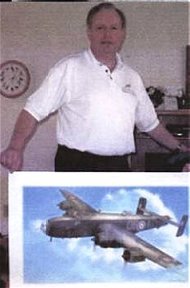 Our
beautiful Halifax print of LW170, "INVINCIBLE ITEM”
Our
beautiful Halifax print of LW170, "INVINCIBLE ITEM”
Contact Karl to purchase one of these prints thereby
contributing to the recovery of LW 170 fund.
Further to these developments, Jim Blondeau, a director
of Halifax 57 Rescue (Canada) and a film producer in Ottawa, will be accompanying
me on the sonar expedition to capture on video all the events and technology
of the expedition. We are planning on having daily reports direct from
the research ship out on the water, via broadband and satellite hook-up,
and are working on preparing a video/photo download site on our website
at www.57rescuecanada.com so that we can, day by day, share
our adventure with you, our members and supporters, and all of the world.
I am looking up now, on my office wall, at the sonar image
of Halifax NA337 discovered in 750 feet of water over 12 years ago in Lake
Mjosa, Norway. I remember, as Project Manager of the recovery of
NA337, how that one image supercharged our project when NA337 was discovered
and this image was released to the media and press. Thousands of people
stepped forward to save NA337 by donating funds and services.
I envision that these events will happen again but this
time it will be a huge historic event beyond anything we have done before.
If we can use the best technology with determination and diligence we will
be successful in saving our Halifax, this aviation treasure. We must be
prepared and ready to save LW170 and we need your continued support.
“PRESS ON REGARDLESS…”
Sincerely
Karl Kjarsgaard
Project Manager |
Eastern Canada
Halifax 57 Rescue (Canada)
Unit 31C – 174 Colonnade Road
Ottawa, ON T0L 1R0 |
Western Canada
Halifax 57 Rescue (Canada)
P.O. Box 606
Nanton, AB K2E 7J5 |
Phones 613-863-1942 or 613-226-4884 Alberta
403-603-8592
A Shot in the dark
Hi
I know this may be a shot in the dark but I am trying
to find an air gunner his name is
Gerald Edwin Morrison RCAF of 78 squadron.
He served with my uncle, Tom Turpin. They were shot down
Oct.1 /42. My uncle was killed, but Gerald Morrison survived as a PoW.
Any information regarding Morrison or his relatives, would
be greatly appreciated .
Sincerely
Scott Turpin
sturpin3@cogeco.ca
Ted Hackett
I don't know if I have sent this to you before but it
is a means of looking up the fate of Bomber Command aircraft during the
war. The web site address is www.lostbombers.co.uk/
When you go into the site you find a list of aircraft, ,and photo, you
go to the one you are interested in and you will find pages and pages concerning
that aircraft type. I did look up a number of aircraft to find out
exactly what happened to friends. Gene had a friend who was a BA
and who was lost on Ops in 1943. As far as I know all she knew was
that he was killed but apparently she had no other information, at least
she never told me of any. I did a search of the site and eventually
found out that they had been on their way to Munich and came down in a
lake. Only one body was ever recovered. I thought you might
find it interesting enough to put in the next issue of Short Bursts.
I tried to find some information on aircraft lost at OTU and HCU but, unfortunately,
they don't seem to be listed.
Do Hope You Can Help Me
Please can you help me? I would dearly love
to trace my unnamed father, who I am assured, by my auntie, was a Canadian
airman based at Fradley mid 1944. He attended a village hall dance at Alrewas
and escorted my birth mother back to her sister's house in Main Street,
making a slight detour over a nearby bridge. I merely wish to know something
of his background and thereby fill a chasm in my life's history. I appreciate
that my request is a little unusual, l but would ask you to understand,
and if humanly possible, help me fill this unknown portion of my life.
My mother's Christian name was Eileen and her sister who accompanied her
to the dance was Irene.
The dance took place on a Saturday evening the last week
of June 1944. I guess there were probable celebrations following the D
Day landings of earlier that month, which of course, brought about the
successful conclusion to the war. I was adopted in September 1945, as
were many, and my entire life has been a happy one, save for the "missing
Canadian link".
I do hope that you feel able to help me in this
quest, though I appreciate that I have very few clues and so I place my
hope and faith in you. Please try your very best on my behalf,
Roger M. Chedgzoy,
Park Cottage, Highwood, Tenbury Wells, WR15 8PB,UK,
rogermalisonm@btinternet.com
207 Squadron
From Dave Sullivan
Good Morning John: No doubt you have heard
the news that Wallace McIntosh has passed away in Aberdeen. The following
url www.rafinfo.org.uk
will lead you to the 207 Squadron site, click on the squadron crest and
then on
Reunions and newsletters to see the many obituaries
that have been appearing in newspapers all over the world. Wallace was
my Gunnery Leader on 207 and we met on a number of occasions after the
war both here in Canada
and the UK. The Christmas cards stopped about two years
ago and I knew that he was not in the best of shape. Wallace was
a very modest hero and a gentleman. His mid-upper gunner was Larry Sutherland,
last known to be
living in Florida, who appeared one morning unannounced
at our door when we lived in Toronto. Larry had sought me out because of
our surnames and knowing that I had been on 207. We spent the morning together
and after
lunch he was off to Chicago where he had a swimming pool
business. As he left he asked me if I had joined the Air Gunner's Association
and I said that I had not done that yet. Very shortly afterwards that I
received a membership card from the Association paid for by Larry. Sadly,
I have been unable to contact Larry, he is not at the last address I had
for him.
Dave S.
Full ahead to the 2010 Olympics
Ed. Wallace McIntosh and Larry Sutherland, of whom
Dave speaks, are featured in Commemorative Issue of Short Bursts 1983 –
1993 Pg. 46.
"Wallace was to become, at one time, the most decorated
air gunner in the RAF. In a 14 month spell between October 1943, and December,
1944, he was awarded he DFM, DFC, and a bar to the DFC."
Larry Sutherland was a great supporter of Short Bursts
and I had the pleasure of sharing his company at a reunion in Edmonton,
September 1998.
A Mustang Dream Realized
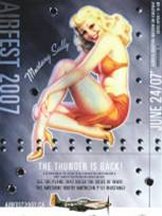
Mustang Sally
Article and photos
by John J. Chalmers
442 Reeves Crest NW
Edmonton AB T6R 2A3
johnchalmers@shaw.ca
|
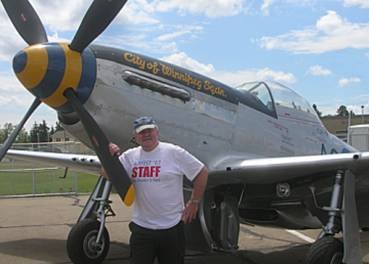
Bob May
with his P-51
City of Winnipeg Squadron
|
A youthful interest in a great warbird, the P-51 Mustang,
has been realized by a Winnipeg aviator who now flies a splendid example
of that famous aircraft of the Second World War. Bob May began gathering
Mustang parts and components 18 years ago to restore the aircraft to its
original glory.
In only his third flight in the aircraft, Bob flew
it to Edmonton on June 22 to put it on show at Airfest 2007 at the Alberta
Aviation Museum. On the day of Airfest, June 24, Bob spent a full day beside
the aircraft answering questions and talking to visitors about his beautifully
restored fighter plane.
The poster designed for Airfest features a pin-up
girl in the style of wartime nose art that appeared on aircraft. “Mustang
Sally” was not only the main illustration on the poster, so appropriate
with the rivets and bullet holes in the background, but the title of a
song that dates back to 1965 and was recorded by many artists. Although
the song refers to Mustang cars and not aircraft, it was appropriate for
both. Besides the P-51 on display, a local Mustang automobile owners club
displayed their four-wheel models at Airfest.
Painted in RCAF post-war colours and insignia, Bob
May’s P-51 Mustang actually bears an American registration number, as the
aircraft is kept in North Dakota where it was restored. Bob began acquiring
parts for the aircraft in 1989 and restoration was completed in 1994, but
he didn’t fly it himself until the day before he brought it to Edmonton.
Although he is new to the cockpit of the Mustang,
he is not new to flying, having spent a career in the aviation field, including
operating Keewatin Air with his wife, Judy, for 35 years. With their main
base in Rankin Inlet, Nunavut, and another in Churchill, Manitoba, they
developed an advanced aeromedical program and also operated Learjet 35
aircraft internationally for a number of years as Critical Care International.
Although both companies have now been sold, both
Bob and Judy maintain their involvement in aviation with consulting and
participating in aviation organizations. As well, Bob now has two ex-RCAF
Harvards, one flying and one under restoration, both located in the United
States, including one that was stored in a Nebraska barn before Bob acquired
it. His interest in vintage aircraft goes back many years, having previously
owned and flown a 1930’s N3N-3 biplane built by the Naval Aircraft Factory.
That was followed by a T-6 Texan, the American version of the Harvard.
“I can’t tell you much about flying the Mustang
yet, as its all pretty new,” says this experienced pilot. “My impression
is that I spent too much time worrying about all the stories I had read
about how challenging and dangerous it was. In fact, it’s a lot easier
to handle than the Harvard and just needs lots of right rudder! It is a
very nice change on landing from the Harvard, which I’ve come to respect
as never being done surprising the pilot until it is shut down. The Mustang
is a joy to handle on the ground!”
And it looks great in the air, as well as on the
ground. When he left Edmonton for home in Winnipeg, the sight of a Mustang
making a low pass over the City Centre Airport was something not seen there
for years, and the sound of the mighty Merlin engine was music to the ears
of anyone who saw it. Thanks to his efforts in restoring, flying and displaying
his beautiful aircraft, Bob May now shares his vintage fighter plane with
others who are interested in aviation history.
For more info on Bob’s warbird and other Mustangs, see
http://www.mustangsmustangs.com/p-51/survivors/p51listD1.shtml
For more photos of Airfest 2007 at Edmonton, including
photos of the Mustang, go to http://photoshare.shaw.ca/gallery/johnchalmers
and click on Airfest 2007.
To see the Mustang fly and hear its Merlin engine, watch
the movie on YouTube at http://www.youtube.com/watch?v=T6ijo0DQyuo
Ed. John Chalmers has been a contributor to Short Bursts.
His article reminds me of the 1950s when there were eight Mustang aircraft
in mothballs, at Winnipeg Stevenson airport where Western Air Command was
then located.
War Assets Disposal Corporation in Ottawa put the Mustangs
up for sale to the highest bidder. A consortium in Winnipeg entered a bid
of $800.00 each on the aircraft. When they had not heard, they phoned Ottawa
and were directed to the person administering the bids. Her name was Mrs.
BIDGOOD. Are there any readers out there, especially in Ottawa, who know
this lady?
The Consortium lost out to a bidder who paid $1,500.00
per aircraft. Correct me if I’m wrong, but I understand the Mustangs ended
up in Cuba, forming Casto’s air arm in his fight against Batista.
Northern Alberta Branch Report
Good evening John. I guess it is about time I sent
something for Short Bursts so people will know that we are still alive
out here. So Here goes.
Not much doing in Northern Alberta at this time of year
however we still have our monthly luncheon meetings and we manage
to attract around 10 or 12 members to the Norwood Legion. . We have
our regulars but occasionally we have a "drop in" so to speak. We
always have four or five Ladies present , usually those whom we refer to
affectionately as "the Merry Widows". At the end of June we
held what has become our yearly barbecue at the Log Cabin in Edmonton.
There were 35 in attendance including a few of our friends from the Wartime
Aircrew Association. The barbecue steak and chicken with all
the trimmings was, as usual, excellent with wine and beer available to
wash it down. A good time was had by all.
We will be attending the function at Nanton on August
25 but we are not sure how many of our members will be there. We
have four positives and about three or four "maybes". It is a long drive
for some members and, of course, the price of petrol is a factor.
We will make sure we send an account of the day and some photographs for
the October issue.
Cheers.
Ted Hackett
John Moyles
In the June/07 edition of Short Bursts there is a request
from Stefan McKenna seeking information on his Uncle, Gerald McKenna, 162
Squadron, killed in action and buried in Iceland.
A gentleman, Lauren Carlson, member of our morning coffee
group, was travelling to Iceland, and agreed to visit the military
cemetery at Reykjavik, and photograph Gerald’s grave site.
When Lauren pressed back the flowering shrub to get the
inscription, he discovered a bird’s nest containing one egg. With death,
there is life.
We thank Lauren and Sheila for taking the time to obtain
these pictures.
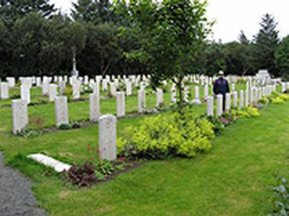
Sheila Carlson standing
by Gerald McKenna’s grave.
This picture shows how well
the grounds are maintained.
|
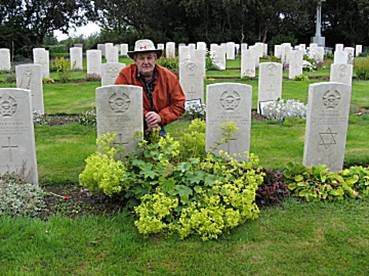
Lauren behind Gerald’s memorial
|
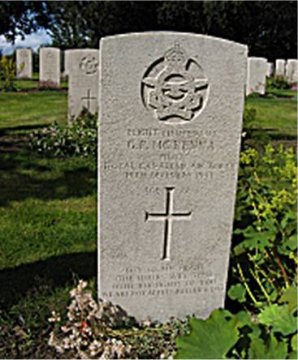
Inscription:
Flight Lieutenant
G. P. MCKENNA
Pilot
ROYAL CANADIAN AIR FORCE
19TH DECEMBER 1944
AGE 22
"BOY OF MY HEART
THE HOURS WILL TEEM
WITH THOUGHTS OF YOU
WE ARE NOT APART"
MOTHER & DAD
Sept. 26, 1942, 7 BR Squadron,
Prince Rupert, B.C.
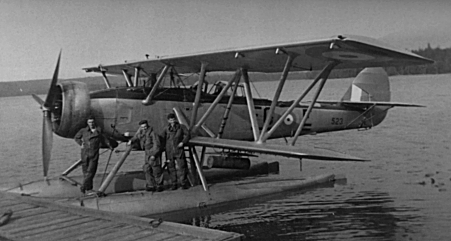
L to R – John Moyles, WAG, Hank Hankinson, Nav.
Gerald Mckenna, pilot,
returning from Pacific Patrol in Blackburn Shark.
Picture taken by Tommy Cousins –
WAG, with his verboten camera.
The National War Museum Bomber
Command Plaque Controversy
The Canada War Museum, to my knowledge, has done nothing
with regards to removing the insulting plaque that insinuates that we veterans
of Bomber Command, who bombed Germany during WW2, are "War Criminals"
I would like to suggest that in your next publication,
you urge the veterans who will be parading in the Nov. 11th ceremonies
at the Cenotaph in Ottawa to congregate at the Museum after the 11 o'clock
ceremonies and picket and
boycott the Museum. If the Ottawa branch of the Legion
in association with the Airforce Association get together to organize this
action, it'll make the public aware of the Museum's Board of Directors
insensibility to the feelings of us veterans.
The following bumper sticker is self explanatory.
IF YOU DON'T STAND BEHIND OUR TROOPS....
...FEEL FREE TO STAND IN FRONT OF THEM....
We, in Bomber Command
NOT ONLY STOOD BEHIND THEM, BUT FLEW IN FRONT OF THEM....
E.J. Chenier CD
Flight Lieutenant (Ret'd)
deed2ed@shaw.ca
208-815 St. Anne's Rd
Winnipeg, MB R2N 3X6
204 255 2080
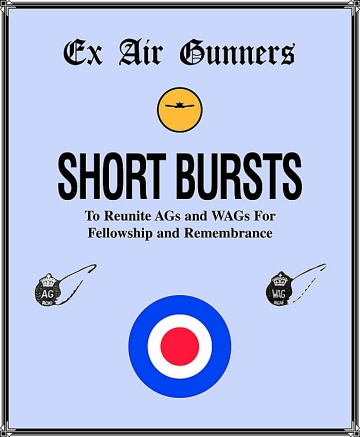



 Ed.
I was not able to find a picture of a B-25 Mitchell with RCAF markings,
so we resorted to reproducing the cover of George Olson’s book of Operational
Poetry, NO PLACE TO HIDE.
Ed.
I was not able to find a picture of a B-25 Mitchell with RCAF markings,
so we resorted to reproducing the cover of George Olson’s book of Operational
Poetry, NO PLACE TO HIDE.
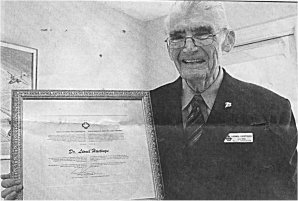
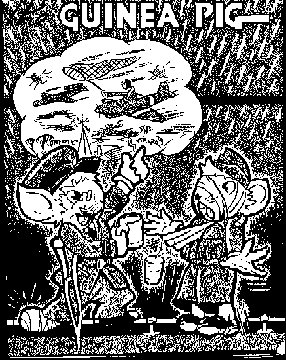




 “…..
ever since the reunion I’ve wanted to tell you of how wonderful it was.
I know you would have loved it if you could have been there. What a wonderful
group of people. I never doubted it but I was struck by how rock solid
great it all was – because of the people. It was a great program. Harry
Kierson, Jean Doerne and Bud Crookes, carried the day. Harry gave a presentation,
with slides, about the Battle of the Atlantic, relaying messages from members
with such caring. Jean Doerne kept the process moving and spoke with such
great heart.
“…..
ever since the reunion I’ve wanted to tell you of how wonderful it was.
I know you would have loved it if you could have been there. What a wonderful
group of people. I never doubted it but I was struck by how rock solid
great it all was – because of the people. It was a great program. Harry
Kierson, Jean Doerne and Bud Crookes, carried the day. Harry gave a presentation,
with slides, about the Battle of the Atlantic, relaying messages from members
with such caring. Jean Doerne kept the process moving and spoke with such
great heart.




 Our
beautiful Halifax print of LW170, "INVINCIBLE ITEM”
Our
beautiful Halifax print of LW170, "INVINCIBLE ITEM”





